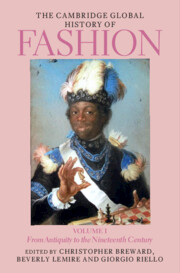Book contents
- The Cambridge Global History of Fashion
- The Cambridge Global History of Fashion
- The Cambridge Global History of Fashion
- Copyright page
- Contents for Volume I
- Figures for Volume I
- Maps for Volume I
- Table for Volume I
- Contributors for Volume I
- Preface
- 1 Global History in the History of Fashion
- Part I Multiple Origins of Fashion
- 2 Towards a History of Fashion Without Origins
- 3 Fashion in the Ancient World
- 4 Fashion on the Silk Roads, 500–1300
- 5 Distinguishing Oneself
- 6 The Material Regulation of Fashion
- Part II Early Modern Global Entanglements
- Part III Many Worlds of Fashion
- Index
- References
3 - Fashion in the Ancient World
from Part I - Multiple Origins of Fashion
Published online by Cambridge University Press: 04 August 2023
- The Cambridge Global History of Fashion
- The Cambridge Global History of Fashion
- The Cambridge Global History of Fashion
- Copyright page
- Contents for Volume I
- Figures for Volume I
- Maps for Volume I
- Table for Volume I
- Contributors for Volume I
- Preface
- 1 Global History in the History of Fashion
- Part I Multiple Origins of Fashion
- 2 Towards a History of Fashion Without Origins
- 3 Fashion in the Ancient World
- 4 Fashion on the Silk Roads, 500–1300
- 5 Distinguishing Oneself
- 6 The Material Regulation of Fashion
- Part II Early Modern Global Entanglements
- Part III Many Worlds of Fashion
- Index
- References
Summary
‘Show me the clothes of a country and I can write its history.’1
- Type
- Chapter
- Information
- The Cambridge Global History of FashionFrom Antiquity to the Nineteenth Century, pp. 51 - 77Publisher: Cambridge University PressPrint publication year: 2023



